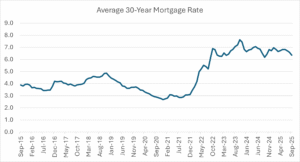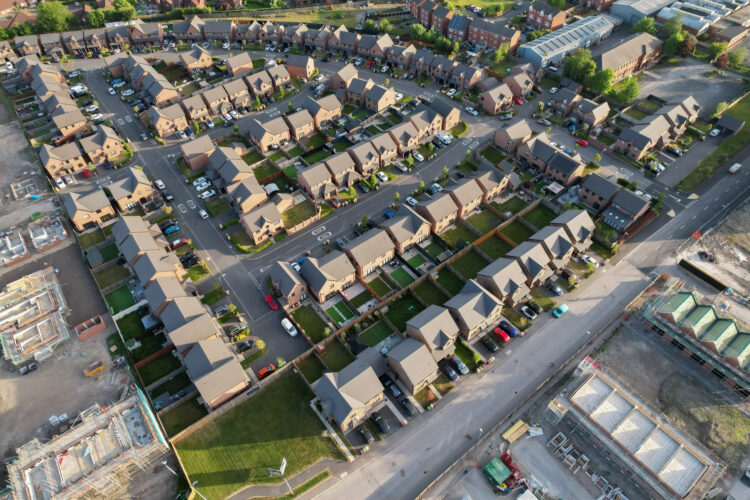Ohio’s rollout of two new housing initiatives as part of Ohio House Bill 96 comes at a critical time, as Ohio’s major industrial legacy cities face declining population projections, a challenge that, while reflective of national trends, is compounded by the housing crisis and difficulties in attracting and retaining prime working-age talent. Addressing housing market dynamics is a key piece of the puzzle to sustain Ohio’s competitive position and ensure its long-term attractiveness for talent, business expansion and overall economic vitality amid demographic headwinds. This article explores how new programs like the Residential Economic Development District (REDD) and Residential Development Revolving Loan Program (RDRLP) aim to resolve the issue and incentivize development.
Housing infrastructure is a foundational component of a healthy and growing economy. When housing becomes scarce or financially inaccessible to the workforce, economic expansion faces significant constraints. A reliable supply of workers is essential to any successful economic development strategy, and that workforce depends on access to stable, affordable housing.
A healthy housing stock and a competitive talent pool work hand in hand in the attractiveness of the region for business expansion and investment. These variables are interconnected, and together they can make or break a region’s competitive positioning for transformative development projects.
How Ohio is Addressing its Housing Challenges
“Housing is in a state of crisis in Ohio. We need to drastically increase supply, and promote competition amongst housing providers, which will lead to more affordable homeownership opportunities and lower rents. Fixing the problem of housing affordability is critical to Ohio’s future.”
State Senator Louis W. Blessing, III shared this statement during the first hearing of the Senate Select Committee on Housing, capturing the broader sentiment held by many of Ohio’s leaders regarding the state’s housing challenges.
In recent years, housing has become one of the most pressing issues nationwide. Affordability concerns, limited supply, NIMBY resistance, private equity investment and the rise of build-to-rent developments have all contributed to a complex and challenging housing market landscape. The emergence of the COVID-19 pandemic also fundamentally reshaped the American housing market. Beginning in 2020, historically low mortgage rates combined with massive federal stimulus programs, including direct housing relief checks, ignited a surge in housing demand. Millions of households suddenly had both the financial means and the incentive to buy or upgrade their homes. At the same time, remote work opportunities encouraged relocation, often toward more suburban and smaller markets that had previously only seen modest growth. Knowing this an important question emerges. Is Ohio’s housing market in a true state of crisis?
| Median Listing Price | ||||
| Area of Focus | Ohio | Cleveland MSA | Columbus MSA | Cincinnati MSA |
| 2025 (YTD) | $277,334 | $259,797 | $372,834 | $341,618 |
| 2024 | $269,130 | $250,728 | $376,579 | $347,498 |
| 2023 | $253,079 | $227,469 | $376,354 | $366,804 |
| 2022 | $216,729 | $204,592 | $334,733 | $321,500 |
| 2021 | $203,315 | $203,517 | $301,504 | $319,945 |
| 2020 | $199,158 | $207,402 | $308,564 | $305,667 |
| 2019 | $183,733 | $195,364 | $291,143 | $269,998 |
| 2018 | $167,813 | $182,376 | $278,770 | $255,233 |
| 2017 | $147,874 | $162,913 | $243,282 | $224,012 |
| % Change (2019– 2025) | 50.9% | 33.0% | 28.1% | 26.5% |
Source: Federal Reserve of Economic Data
The table above details the median listing price across the State of Ohio and its three largest metropolitan areas, Cleveland, Columbus and Cincinnati. The table specifically focuses on the change from 2019, the year prior to the COVID-19 pandemic, through August of 2025. Ohio overall experienced a 50.9% median listing price increase since 2019. While the three major metropolitan areas experienced increases ranging from 26.5% in Cincinnati to 33.0% in Cleveland. While Columbus and Cincinnati experienced significant price increases from 2020 to 2023, the median listing price in these markets have begun to decrease from their peaks. Cleveland has experienced less rapid growth compared to its counterparts but has steadily increased to a current all-time high of $259,797 in 2025. While this data points to a significant rise in home prices across the state, it must be measured alongside an analysis of median household income to fully understand affordability.
| Housing Affordability in Ohio | |||
| Year | Median Household Income | Median Listing Price | Home Cost Relative to Income |
| 2025* | $85,512 | $277,334 | 3.2 |
| 2024 | $80,520 | $269,130 | 3.3 |
| 2023 | $73,770 | $253,079 | 3.4 |
| 2022 | $67,520 | $216,729 | 3.2 |
| 2021 | $62,690 | $203,315 | 3.2 |
| 2020 | $60,380 | $199,158 | 3.3 |
| 2019 | $64,660 | $183,733 | 2.8 |
| 2018 | $61,630 | $167,813 | 2.7 |
| 2017 | $60,690 | $147,874 | 2.4 |
| % Change (2019-2025) | 32.2% | 50.9% | 14.1% |
Source: Federal Reserve of Economic Data
* Estimate for 2025
The data in the table above illustrates a deterioration in housing affordability across Ohio over the past several years. From 2019 to 2025, the median household income across Ohio rose by 32.2%, while at the same time the median listing price rose by 50.9%. The overall housing affordability gap is reflected in the Home Cost Relative to Income ratio, which measures how much greater the cost of a home is compared to the annual median household income. Prior to 2020 the ratio in Ohio remained below 2.8, but by 2025 the ratio had climbed to 3.2. While the increase of 14.1% since 2019 may seem modest on paper, in practice it represents thousands of families who are now priced out of homeownership.

Source: Federal Reserve of Economic Data
While the rising median listing price of home prices alone has strained affordability in Ohio, the burden has been made even heavier by the rapid increase in mortgage rates. Prior to 2021, home buyers across the nation benefited from historically low borrowing costs. That dynamic shifted dramatically beginning in 2022. As the Federal Reserve raised interest rates to combat inflation, mortgage rates surged, climbing from around 3% in late 2021 to more than 7% by late 2022. Since then, rates have hovered in the 6–7% range, effectively doubling the cost of borrowing compared to just a few years prior. When paired with Ohio’s median listing price growth, a 50.9% increase since 2019, these higher mortgage rates have made housing far less affordable. To address the challenges of this shifting housing market, state lawmakers have introduced two new programs focused on housing.
Residential Economic Development District (REDD) Grant Program:
The stated intent of the REDD program is to “encourage major workforce housing projects in areas of the state that otherwise would not attract such developments and to increase home ownership among Ohioans.” The program codified in R.C. 122.636. The REDD program provides grants to counties, townships and municipalities within 20 miles of a “major economic development project” that adopts pro-housing development polices and approves major workforce housing projects. For purposes of the program, a major economic development project is defined as a project that creates 700 or more permanent jobs or where $700 million in private investment is used towards a designated project site. Recent examples of job creating projects that would meet the standards for the REDD program are the Anduril development in Pickaway County and the LGES and Honda EV Battery Plant in Fayette County. This program will receive $10 million in FY 2026 and $15 million in FY 2027. Application procedures and scoring metrics are expected to be published on the Ohio Department of Development’s website no later than December 31, 2025.
Residential Development Revolving Loan Program:
The RDRLP promotes higher-density single-family housing by requiring a minimum of four dwellings per acre in areas zoned exclusively for single-family residential use. The RDRLP is codified in R.C. 122.98. Managed by the Ohio Department of Development, this program is designated to receive $100 million in FY 2026 with the ability to reallocate funds to FY 2027 if funds go unused. Funding is available only to municipalities, townships and counties with populations under 75,000 that issued fewer new single-family construction permits in the most recent calendar year than the statewide county average in Ohio. Currently, 53 counties appear to be eligible for this program.
Eligible recipients may apply the awarded funds toward projects that develop, repair or upgrade water, sewer, road, electric or gas infrastructure required for the construction of single-family residential dwellings. Loan requests are limited to the lesser of 50% of total project costs or $30,000 per dwelling served. Loans will be issued on a rolling basis, subject to available funding, and will carry an interest rate equal to the effective federal funds rate at the time of the loan agreement. The Department of Development is required to open the initial round of funding no later than January 1, 2026. The Department of Development will publish program rules and guidelines in the coming months. An official list of counties that could qualify for a Residential Development Revolving Loan will be provided as new data on county population and building permits is released.
RDRLP Program Rules:
- Loans limited to 50% of project cost or $30,000 per dwelling, whichever is less.
- Funds must support qualifying single-family housing (not LIHTC projects).
- Borrowers (local governments) must waive certain zoning/building requirements and submit subdivision plats.
- The loan interest rate is set at the federal funds rate at the time of agreement.
- Properties built with loan-funded infrastructure are exempt from property tax but must make equivalent PILOT payments to repay the loan.
- Up to $500,000 annually may be used for administration; no additional fees allowed.
- Loan repayments are recycled into the fund; projects are exempt from Ohio’s Prevailing Wage Law.
- Unused funds at the end of FY 2026 are reappropriated to FY 2027.
What This Means for You
These two new housing programs create fresh opportunities for real estate investors, developers and business owners to bolster the housing stock throughout Ohio. At the same time, they bring added layers of complexity, particularly when it comes to program timing, eligibility requirements and compliance considerations.
Contact
Navigating these changes effectively will be critical to maximizing potential benefits while avoiding costly missteps. If you would like to learn more about how these programs may impact your business or upcoming projects, please reach out to KJK’s Economic Development practice group at 216.696.8700.
